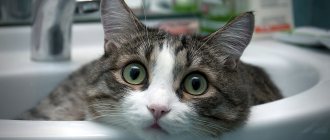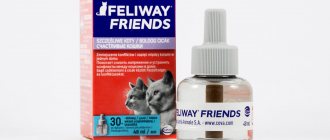Cats by nature are clean animals. Scientists have calculated that purrs devote approximately 3-5 hours a day to licking their fur coats. However, both long-haired and short-haired cats still need to be bathed using special shampoos and running water.
So, for example, Persians and Siberians are usually bathed once every 1.5-2 months or less, and British or Scottish shorthairs - once every 4-6 months. What about hairless cats? How often should you bathe Sphynxes (Don and Canadian), Peterbolts, Ukrainian Levkoys, elves and bambinos? In this article we will figure out whether it is possible to bathe a Sphynx and, if so, how often and how to wash it correctly.
Why wash your Sphynx?
The skin of the sphinx is like delicate velor.
Such exquisite “clothing” does not protect the animal from the cold, so the body temperature of this breed is 1–2 degrees higher than that of ordinary cats. For this reason, the sweat and sebaceous glands work more actively. As a result, the skin quickly becomes dirty. Fat and sweat accumulate in the folds and create a favorable environment for the development of bacteria. Add to this house dust, lint from carpets and upholstered furniture, and particles of toilet filler.
If you do not wash off all this dirt in a timely manner, in 2-3 weeks the velvety skin of the Sphinx will acquire a brown tint. The animal begins to emit a sharp, unpleasant odor and leaves marks on the upholstery of furniture and other surfaces. This is why the Sphynx needs to be washed regularly and more often than other cats.
Frequency of bath procedures
The skin of animals, like the human epidermis, tends to secrete fat. Sphynx cats are no exception - they take care of their skin on their own, but this may not always work out well for them. The frequency of bathing for your pet should be determined individually. But it is not recommended to wash your Sphynx too often to avoid washing off the natural fat layer and causing various problems. It is enough to bathe the cat once a month, but if there is no need, you should do it less often.
The degree of contamination of animals depends on feeding, and on the lifestyle of sphinxes, their character. Often, fatty food provokes rapid contamination of the skin.
During the hot season, cats' skin becomes dirty faster. In these cases, it is not necessary to constantly bathe the cat; it is enough to occasionally wipe its body with wet wipes.
If your pet gets dirty too often - this is indicated by plaque on the ears and skin - then most likely he has problems with his diet.
Taming of the Shrew
How to bathe a Sphynx kitten who does not want to take a bath for any reason? If you were unable to accustom your cat to water procedures from an early age, it is better to abandon this idea. Some cats perceive bathing as a violation of their rights and freedoms. They are ready to defend them to the bitter end.
In this case, you should not use force or try to break resistance. Otherwise, you will achieve one thing - the obstinate will hate you for life. Better humble yourself and stock up on wet wipes. You will not wash them with them, but rather wipe them over the delicate peach-like skin of the sphinx as often as necessary.
It doesn't matter how you implement hygiene measures. The main thing is that your hairless friend is always clean and healthy.
How many times should you bathe?
Water procedures must be carried out as the pet becomes dirty, usually once or twice a month.
It is better to determine how often to wash your Sphynx based on age, individual observations and the conditions in which it lives. If the cat begins to smell bad, becomes sticky and greasy to the touch, and dust is visible in the folds, then it’s time to carry out water treatments. On average, hairless pets are bathed once every 14-30 days. If the animal is sick, the procedure is postponed until complete recovery, since a higher water temperature will not help wash the pet safely.
Veterinarians do not recommend carrying out procedures more often unless there is an urgent need, because you can wash away the level of fat on the skin necessary for protection. This is fraught with the appearance of skin infectious diseases and rashes. Another risk of frequent water procedures is hypothermia. Hairless cats do not have an undercoat to keep them warm, and therefore quickly freeze and catch colds. If the sphinx gets dirty, it is better to wipe it with a damp cloth or a non-scented napkin.
How to train a Sphynx to bathe
It is difficult to train an adult cat to bathe. The process begins at a young age, but not older than 4 months and not younger than 2. Optimally - from 2-3 months. After 3-4 baths, the kitten begins to perceive washing as an inevitable procedure, and some even begin to like it. There are many reviews from owners that the Sphynx cat loves to swim.
If the usual method is ineffective, breeders of hairless cats recommend starting bathing training with a dry bath. The steps are simple - put the kitten in a bath without water and treat it with a treat. Starting from one and a half to two months, you can have one feeding in the bathroom. After 1-1.5 weeks of such training, the kitten will happily jump into the bath.
How to teach calm bathing?
Sphynx owners advise giving a treat after each water procedure, then bathing will no longer be a big stress for the animal. The greatest reward is given if the animal behaves calmly.
To teach your Sphynx to bathe, you need to adhere to the following recommendations:
For bathing, it is recommended to collect water without the presence of an animal and its volume should not be large.
- You should not fill a basin or bathtub full. To wash the animal, it is enough to pour liquid up to the ankles.
- Filling a basin or bathtub should be done without your pet, otherwise he will be scared by the roar of water ahead of time.
- Immediately after traveling or relocating an animal to a new home, it is better to postpone water procedures. It takes time for the sphinx to calm down and get used to the situation.
- Feeding before bathing is prohibited, because this will negatively affect physical well-being and can lead to gastrointestinal upset and vomiting.
- If your cat has an acute negative reaction to bathing, you can hide the water by whipping up a fluffy layer of foam.
- Vaccination is a contraindication to water procedures. You should pause for 14 days.
- If it is cold in your home, then swimming is strictly prohibited. In warm weather, it is also necessary to close windows and doors to avoid drafts.
- The sphinx's negative attitude towards water procedures may be associated with further hypothermia, so the pet must be wrapped in a towel and covered with a blanket.
- Washing two animals at the same time is a bad idea, which will not allow the owner to control the process and will increase stress.
Diet
One of the myths about Sphynxes is related to the diet of these cats: they are believed to be very picky and squeamish. In fact, it's the other way around. The accelerated metabolism characteristic of the breed has made Sphynxes food lovers. And for a reason: they need energy to maintain body temperature. It is advisable to feed your cat food specially designed for the breed. For example, Royal Canin Sphynx is suitable for animals older than 12 months. It takes into account all the nutritional needs of hairless cats.
PeterbaldThe Sphynx owner must strictly follow the veterinarian's recommendations regarding feeding. Otherwise, you can easily make your pet obese.
The Sphynx is a cat whose maintenance requires attentiveness and care from the owner. But the main thing that should surround a pet is love and affection. Only then will he be truly happy.
Duration and frequency of the procedure
Like the human epidermis, the skin of animals secretes fat. Frequent water procedures that remove the natural fat layer lead to metabolic disorders and cause various diseases, including skin diseases.
Something else interesting: Furminator cat comb is a popular grooming tool
Cats whose skin is covered with hair do not need frequent bathing. Unlike their furry “relatives,” the frequency and duration of water treatments for sphinxes is determined individually. Following the advice of experienced breeders, try to wash your cat no more than once a month.
In the summer, the skin of sphinxes gets dirty faster. However, there is no need to constantly bathe the animal; it is enough to wipe the pet’s body with wet wipes, which can be purchased at a veterinary pharmacy or pet store.
You can deviate from the usual schedule of water procedures if treatment was carried out to eliminate parasitic insects. It is also recommended to thoroughly wash an animal that has recently suffered from some kind of infectious disease and needs to cleanse the skin of drug residues, excess fat and waste products as a result of disruption of the digestive system.
If you notice that the Sphynx's skin quickly becomes dirty and there is always a characteristic oily sheen on it, do not rush to wash your pet. First of all, it is necessary to review his diet. A diet that does not correspond to the characteristics of the breed, as well as food or industrial feed with a high fat content, negatively affects the metabolic process and provokes rapid contamination of the Sphynx's skin.
Water temperature requirements
According to experts in the field of felinology, the body temperature of cats is significantly higher than the human temperature regime. For this reason, it is necessary to control the degree of heating of the water for bathing the Sphinx.
Recommended water temperature is from 36 to 39 °C. At lower temperatures, an animal without fur quickly freezes and becomes hypothermic. Hot water can cause burns and irritation of the skin.
You also need to monitor the air temperature in the room where your pet is bathing. Cold air leads to hypothermia and increases the risk of developing colds.
How to bathe a Sphynx
It would seem like a simple matter to wash the cat. But you need to understand that sphinxes, Canadian or Don, are special creatures. Their unusual appearance, for which this breed is highly valued, is the result of a gene mutation. In other words, it is a mistake of nature. They cannot survive without human care, so they need special care.
Important! Sphynxes do not have eyelashes, which serve as a protective barrier for the eyes from infections and debris. Therefore, it is necessary to wipe their eyes with a clean, soft, damp cloth daily.
Which shampoo for hairless cats should I buy?
The choice of detergents for sphinxes must be approached responsibly. Shampoos for children and adults, even hypoallergenic ones, are absolutely not suitable.
These cats can only be washed with special products that are sold in pet stores:
- Ms.Kiss "Graceful Sphinx". Reviews about it are contradictory. There are no complaints about the cleaning qualities of this shampoo. However, many cat owners do not like strong fragrance;
- Doctor VIC Professional for hairless cats: shampoo + conditioner. Consumer reviews are only positive;
- Le Artis for hairless cat breeds. The delicate consistency of the soufflé cream and excellent washing and cleansing qualities characterize this shampoo.
The most popular, affordable and budget funds are listed. The choice must be made by the owner of the sphinx, based on his own preferences and the reaction of the pet.
Bath accessories
A set of these items should be stored separately from the owner’s bath accessories:
- shampoo for hairless cats;
- small soft sponge;
- favorite toys;
- cloth to lay on the bottom of the bathing container;
- ladle for rinsing with clean water;
- A towel large enough to completely wrap the sphinx.
After each use, bath accessories should be dried and, if necessary, washed or washed.
Water temperature recommendation
Important! It is often advised to set the temperature of the water for a sphinx bath to 38-40 degrees. But this can burn the animal.
Air and water have different thermal conductivity. This needs to be understood. If we put our hand in water at a temperature of 38 degrees, it will seem very hot to us. The cat won't like it either. Therefore, you should start swimming in a cooler setting.
The water temperature should be comfortable for the animal. It is best to determine this tactilely ─ by touch. The water should be pleasantly warm for your hand, not hot! A special thermometer shows 35-36° C. It is with these numbers that you need to start bathing the sphinx. Then you can increase the degree, focusing on the sensations.
Bathing stages
The procedure for bathing a sphinx can be divided into 3 stages:
- Preparatory. Preparing a place for swimming, bath accessories and the animal itself.
Before you wash your cat, you need to trim his claws. This will protect the owner from scratches.
You are supposed to wipe your eyes with a clean damp cloth, drip a special lotion into your ears and clean them with a cotton pad. Your cat may be prone to ear diseases. It is recommended to place cotton swabs loosely in the ears. Then you need to prepare all the bathing accessories and pour water at the desired temperature into a container.
If the action takes place in the bath, it is better to rinse the animal from the shower. Otherwise, you should stock up on water in a ladle or jug for this.
- Basic. Actually swimming.
You should take the cat in your arms and, talking affectionately to it, go to the place where water procedures are performed.
It is recommended to lay an old towel or piece of cloth on the bottom of the bath to prevent your paws from slipping along the bottom. While stroking and holding, you need to put the cat in the water. Distract her attention with a toy.
There is no need to immediately soap and water the animal: let it get used to it first. While bathing, you should try not to splash it in the cat’s face. It is recommended to ensure that foam and water do not get into the Sphynx's eyes and ears. The head, nose and cheeks should be wiped calmly and gently with a damp hand or napkin.
A very soft sponge is suitable for washing the body. You need to quickly soap the cat and carefully rinse off the foam. All this must be done calmly, talking kindly to the animal, not allowing it to show aggression.
If these conditions are met, the first and all subsequent baths will be successful.
- Final.
You need to wrap the cat in a towel and let it dry for a few minutes. You should not actively wipe your Sphynx so as not to cause irritation to the skin. It is advised to simply hold the pet wrapped up, allowing the water to absorb, and then blot the body in the area of the folds.
After bathing, the cat will definitely lick itself. Therefore, it is important to thoroughly rinse off the shampoo during rinsing.
Swimming during vaccination
The information that you should not bathe a kitten during the vaccination period is long outdated. According to American veterinary colleagues, you can bathe even on the day of vaccination. Getting water (rain or splashing in the bathroom) onto the injection site does not cause a local inflammatory reaction, but rubbing the injection site with shampoo on the first day is still not recommended. After vaccination, the optimal period for postponing water procedures is a period of 2-3 days.
Special cases
Swimming during vaccination
The information that you should not bathe a kitten during the vaccination period is long outdated. According to American veterinary colleagues, you can bathe even on the day of vaccination. Getting water (rain or splashing in the bathroom) onto the injection site does not cause a local inflammatory reaction, but rubbing the injection site with shampoo on the first day is still not recommended. After vaccination, the optimal period for postponing water procedures is a period of 2-3 days.
Treatment for ectoparasites (fleas and ticks)
First of all, it is necessary to take into account the instructions for the drug, which state how many days it is not recommended to bathe the animal. On average, regarding high-quality drugs, you should not bathe for 2 days. This period is due to the fact that the drug settles in the sebaceous glands, i.e. is localized in the deeper layers of the skin, so when swimming, the protective layer of the medicine is not washed off.
Modern dermatologists advise bathing before treatment against ectoparasites, at least 1-2 days in advance. This is especially true for long-haired cats, because the skin takes longer to dry than the fur. It is not recommended to apply the drug to wet skin due to the risk of developing a local inflammatory reaction.
Castration
It is better to bathe a cat 5-7 days after castration. This interval is necessary for the incisions on the scrotum to heal after castration. You can use dry shampoo or wipe with wet wipes. A humid environment is not conducive to healing; besides, cats are very clean creatures and excess moisture on the fur will stimulate grooming of the animal in the groin area.
Sterilization
After sterilization, it is not recommended to bathe the cat for 10 days. This period is necessary for the stitches to heal completely. In some cases, abstaining from swimming requires a period of 14 days. You can also use dry shampoo or wet wipe treatment.
Bathing a nursing cat
It is better to wait until the kittens are about 3 weeks old and then fearlessly separate the nursing mother for several hours: thoroughly bathe and dry. For bathing pregnant or lactating cats, it is best to use hypoallergenic veterinary shampoos or baby soap. Before returning the mother to the kittens, be sure to make sure that the shampoo is thoroughly rinsed off and the animal is dry.
Despite the fact that the cat is a self-sufficient creature. Sometimes even she needs extra care and attention. Some breeds cannot do without human care at all. You should not be afraid to bathe your animal and it is better to accustom your cat to water from childhood.
How often can you bathe a kitten?
Important! It is worth dispelling the stereotype that frequent bathing damages the protective layer of an animal’s skin. The most important thing is to choose the right drug. There are many shampoos that are indicated for daily use.
On average, you can bathe an animal once every 3 weeks. If this is not necessary, then it is enough to carry out water procedures 3-4 times a year. For certain indications, bathing several times a week is acceptable. It is an outdated myth that cats are afraid of water. Many animals treat water favorably, but there are also those who cannot be dragged into the bathtub.
Important! Do not bathe kittens with human shampoos. Humans and animals have different pH and skin microflora. The wrong choice of hygiene product provokes skin lesions.
What cat breeds love water?
Some cats were born in areas where a humid climate prevails or there are many rivers and lakes, and some love water simply because it is there and bathing gives them comfort.
Breeds that favor water:
- Turkish van.
- Angora (Turkish Angora).
- Maine Coon.
- Norwegian Forest or Veg.
- Kurilian Bobtail.
- Japanese Bobtail.
- American Bobtail.
- Bengal.
- Abyssinian.
- Manx.
- Savannah.
And the best swimmer is the jungle cat or house cat.
Drying
Due to the lack of long hair, Sphynx cats dry out quickly. But this is not a reason to immediately let them walk around the apartment after a bath. A draft is dangerous for the animal in the first minutes after bathing, so wrap your pet in a dry towel and hold it in your arms. This way the moisture will be absorbed faster.
Don't let your cat freeze after a shower
After this, carefully blot the folds so that there are no areas vulnerable to the cold. A hairdryer is not used to dry sphinxes: they have very delicate skin, and a hot air stream will cause irritation and even burns.
We will need:
— Bathtub filled with water (or basin). The water temperature should be hotter than for humans, approximately 39 degrees. The water depth is about 15 cm, a little less for the first time. The bath should be filled in advance so that your pet does not see it, as cats are very frightened by the sound of pouring water.
— Detergent. A specialized shampoo for Sphynxes is suitable. It is NOT RECOMMENDED to use baby shampoos like Johnson's Baby.
- Sponge. Some people prefer to use a washcloth.
-Several of the Sphynx’s favorite toys (floating, of course). Sphynx cats are very curious and playful by nature, so you can easily entice your pet to play.
-Several small pieces of treats. For example, cream soup in a convenient package. Always remember that you should only reward your pet (both with treats and words) when he behaves really well! The animal should have the attitude “I am calm and obedient - this is right, I am praised and given treats”!
— A ladle for rinsing the sphinx with water while bathing.
— A towel to dry the sphinx. A warm blanket or blanket to wrap your pet in immediately after bathing.
Basic Sphynx care
Like regular cats, the Sphynx needs to have its nails trimmed and its teeth brushed after eating. But the main concerns are related to the lack of fur.
Ear cleaning
Sphynx ears are large, they have no hairs on the inner surface, therefore, due to the active secretion of sulfur, secretions constantly accumulate inside the shell. About once a week it needs to be removed with a cotton pad soaked in a special lotion, for example “Bars”. Cotton swabs are not used as they may damage the ear.
Eye care
Accumulated discharge should be removed from the corners of the eyes as necessary. There is no need to use tea leaves or antibacterial drops unnecessarily. The eyes are wiped with cosmetic and hygiene lotion or boiled water. If the discharge becomes opaque (yellow, gray), the eyelids stick together, or if the eyes look inflamed, you should definitely take your pet to a veterinarian.
So let's get started
We take the sphinx in our arms. He should have been calm and relaxed (like you, of course). We pet him and talk to him in a calm voice. We go into the bath and lower the pet into the water. If everything is in order and he stands calmly in the water, then you can reward him with a small piece of treat. If he tries to jump out, then we hold him in the water with our hands: gently, but confidently and firmly. We make sure not to cause pain or discomfort to the sphinx. As soon as the pet begins to relax, we remove our hands and give him freedom. Don't forget to reinforce good behavior with treats and kind words!
When the sphinx is already calmly standing in the water, you can throw several toys into the bath - let him chase them, this will help him relax more completely. Now you can soap the sponge and proceed directly to washing. We rinse the sphinx with water from a ladle; some allow you to do this from the shower. Be sure to make sure that water does not get into your pet’s ears!
Types of sphinxes and specific care
Sphynx cats, the care and feeding of which have their own specifics, are not one, but two different breeds that differ not only in appearance, but also have peculiarities of maintenance.
Canadian Sphynx: care and maintenance
The fruit of long selection. Canadian Sphynx cats have thin bones and are often in poor health. Their body is covered with thin, almost imperceptible down, which makes skin care difficult. But there are fewer folds on the skin, so you don’t need to monitor at least this.
You should also pay close attention to dental health - caries and oral diseases are not uncommon among Sphynx cats. You will have to brush your teeth or buy special food. Promoting the removal of tartar, as well as regularly visiting the dentist (!).
The Sphynx's small ears do not pose any particular problems.
Thanks to its long legs, the Canadian Sphynx jumps well and high. This should be taken into account when choosing a kitten. You'll have to reconsider your attitude towards knick-knacks on tables and low open shelves.
Don Sphynx: care and maintenance
An indigenous breed bred from a single “hairless” cat. Don Sphynxes have a much stronger physique and are less prone to various kinds of diseases.
Not as capricious and whimsical as Canadians, they are distinguished by irrepressible energy and curiosity, many of them are willful and require an authoritarian approach when raising them, otherwise the cat will definitely decide that he is the boss in the house and will begin to establish his own rules.
Covered all over with folds and folds, the Don Sphynx will require patience when bathing and grooming. After all, each skin fold will have to be thoroughly washed, dried and treated with cream.
Bat ears also cause anxiety for owners as they accumulate dust and wax. You have to pay a lot of attention to them, carefully treating every bend and fold of the auricle.
History of the origin of the breed
Mentions of hairless cats are found in the chronicles of different nations. The lack of fur is due to a genetic mutation. According to scientists, hairless offspring can appear in any cat. It is known that at the beginning of the twentieth century, a whole population of hairless representatives of the cat world lived in Mexico. True, with the onset of cold weather, these animals still partially grew hair, and they also had mustaches. Soon the line with an unusual appearance disappeared.
In 1966, in the small Canadian province of Ontario, an ordinary black and white shorthair cat gave birth to kittens. One of them was completely different from the others. The owner named the bald, wrinkled kitten Prune, which means “prune” in English. When he matured, the owner decided to consolidate his characteristics by crossing the cat with his mother. In several litters it was possible to obtain kittens that were hairless.
A few years later, in the American state of Minnesota, two hairless kittens from the same litter appeared in one of the nurseries. When they grew up, active selection work began to consolidate the characteristics. Hairless cats were bred with representatives of different breeds, but the best results were achieved when crossing with Devon Rex. Descendants of Prunes from Canada also took part in the work.
The new breed did not immediately gain recognition. Felinologists feared that the mutation could cause a number of serious diseases. However, time has put everything in its place. The ice began to break in 1986 when TICA first allowed hairless cats to be exhibited. A few years later, the CCA organization decided to take a similar step, and in 2002, the CFA. At first the breed was called the Canadian Hairless, then it was given a more euphonious name - the Canadian Sphynx.
Bathing a nursing cat
A nursing cat is constantly on edge. The responsibility for her offspring falls on her fragile shoulders, so all her attention is focused on the kittens. She definitely won’t thank you for a sudden bath.
If your nursing cat becomes too sticky and dirty, wipe her skin with wet wipes. Clean the folds and face with a cloth soaked in warm water. Breeders of Canadian Sphynx cats need to be attentive to the hygiene of the cat's skin folds, since this breed has significantly more of them than, for example, the Don Sphynx. Return to your usual bathing procedures 1.5 - 2 months after giving birth.
What to consider when bathing a cat without hair
It is useful for the owner of the Sphinx to remember:
- The first bath of a young pet should be done after the kitten has settled into its new home;
- It is better to wash the animal on an empty stomach, and after the procedure you need to feed it especially tasty. This is how the cat will form and strengthen a positive conditioned reflex: water procedures entail pleasant moments;
- there should be no drafts in the room where the pet is bathed, because Sphynx cats are susceptible to colds. If the house is cool, you can heat a towel;
- cats are afraid of the noise of pouring water, so you should fill the bath in advance;
- During the first bath, it is better to rinse the Sphynx using a ladle: a shower can be scary.
If the owner does not dare to wash the cat himself for the first time, there is an option to turn to the services of a groomer. A specialist can carry out water procedures at home or in a pet salon.
It turns out that there is nothing complicated about bathing sphinxes. Accuracy, a kind word, a caring attitude - and your pet will get used to the water and will take baths with pleasure.
Useful tips
- It is better to fill the bathtub or basin in the absence of the cat, so as not to expose it to stress ahead of time - the sound of water often frightens animals.
- You should not take the kitten to bathe immediately after acquiring it - let the animal first go through the stress of moving.
- You can stock up on your pet's favorite treat and reward him after good behavior during bath time. This way the animal will develop a useful habit. If a cat behaves very badly during bathing, then you should not give him a treat.
- The bathing procedure is best done on an empty stomach of the cat to prevent embarrassment.
- If the cat is too afraid of water, then create foam on its surface. Usually fear arises due to the fact that the cat does not see the boundaries of the water.
Sources
- https://MoiKoty.ru/porody/sfinksy/kak-myt
- https://KoshkaMurka.ru/241-kak-kupat-sfinksa.html
- https://InfoKotiki.ru/pr/lysye/kak-kupat-sfinksa.html
- https://68koshek.ru/soderzhanie/uhod/kak-pravilno-kupat-sfinksa
- https://ourkoshki.ru/uhod/kak-myt-sfinksa.html
- https://litbro.ru/porody-koshek/sfinks/kak-kupat-sfinksa
- https://sbc-samaris.ru/sfinks/kak-chasto-kupat-sfinksa.html
- https://101hvost.ru/koshki/yhod-i-vispitanie/kak-myt-sfinksa
- https://MyFavoritePet.ru/poroda-okras/kak-chasto-mozhno-kupat-sfinksa.html
- https://KotPoloskin.ru/porody/kak-kupat-sfinksa-kotenka.html
[collapse]
Selecting accessories
Bathing representatives of the cat family, regardless of breed, is a mandatory hygienic procedure, which does not cause much enthusiasm among pets and often causes stress. Correct organization of the procedure will help to avoid negative perception of this process.
When bathing the sphinx, you will need a shallow basin or a small bath, the water level in which should be no more than 15 cm. It is better to cover the bottom of the bathing container with a towel so that the cat’s paws do not slip. The cat is afraid of running water, for this reason it is better to fill the bath with water in advance.
Prepare rubber toys for your pet. Curiosity will play a role as one of the main character traits of representatives of the Sphynx breed, and the pet will happily frolic in the bathroom with new toys. You can also stock up on your favorite treats and reward them for good behavior during bath time.











